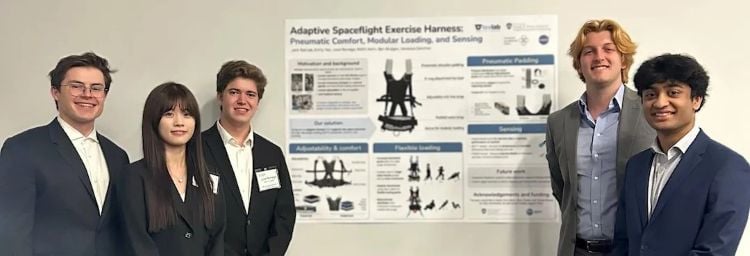What new exercise methods can be devised for astronauts in space under microgravity conditions? This is what a recent study conducted submitted to the 2025 Technology Collaboration Center’s (TCC) Wearables Workshop and University Challenge hopes to address as a team of Rice University engineering students developed a new type of space exercise harness that could make exercising under microgravity easier and more comfortable.
For the study, the students designed and developed a customizable astronaut exercise harness that measures load distribution at pressure points (shoulders, hips, etc.) to mitigate injuries from body shifts during exercise and temperature and humidity changes during exercise. Along with improved technology compared to current harnesses, the new harness also provides an enhanced level of comfort that prevents unnecessary skin abrasions.
“This challenge gave us the freedom to innovate and explore possibilities beyond the current harness technology,” said Emily Yao, a Rice undergraduate and part of the five-member team comprised of four undergraduates and one graduate student that developed the harness. “I’m especially proud of how our team worked together to build a working prototype that not only has real-world impact but also provides a foundation that NASA and space companies can build and iterate upon. This makes the entire experience incredibly rewarding. It’s moments like these that remind me why I love designing with and for people.”
In the end, the harness was chosen as the winner for the Best Challenge Response Award, thus potentially paving the way for this harness to be improved function and use, and possibly real-world use by astronauts in space. Along with improving exercise and physical health, this harness could provide a boost to astronaut mental health due to its simplicity and customizable design.
Astronauts exercising in space has been happening almost since the beginning of the Space Age, as Gemini astronauts used off-the-shelf exercise equipment to combat the effects of microgravity. Beginning on Apollo 7, NASA began using the Exer-Genie Exerciser, as Apollo 7 was the first mission to exhibit enough room inside the spacecraft for astronauts to conduct exercises.
The Exer-Genie consisted of a metal shaft and nylon rope that the astronauts could adjust to their preferences. To use the Exer-Genie, astronauts would pull on the rope, resulting in friction and resistance, enabling them to perform more than 100 basic exercises designed to maintain muscle mass while combating microgravity. The Exer-Genie was equipped with all crewed Apollo missions (Apollo 7 through 17) but were actually used by the astronauts on Apollo 7, 8, 9, 11. 12. And 16.
This study comes as NASA plans to send astronauts back to the Moon for the first time since Apollo 17 in 1972 with the goal of establishing a permanent human settlement on the lunar surface. One of the goals of a lunar settlement will be to test technologies for a future crewed mission to Mars as part of NASA’s Moon to Mars Architecture. Following the successful uncrewed Artemis I mission in November 2022, the crewed Artemis II mission is scheduled for early 2026 and will send four astronauts around the Moon, mirroring Apollo 8’s historic flight. This will be followed by Artemis III, which is scheduled to occur in mid-2027 with a four-person crew and landing two on the lunar surface.
Sending astronauts to the Moon and Mars demonstrates how humans will endure longer periods of reduced gravity on both the Moon and Mars at one-sixth and one-third gravity of Earth, respectively. While this isn’t full microgravity as experienced on the International Space Station (ISS), reduced gravity still results in decreased muscle mass and bone loss that astronauts need to maintain to continue their mission, but especially when re-adapting to Earth’s gravity when they come home.
How will this new exercise harness help astronauts in space in the coming years and decades? Only time will tell, and this is why we science!
As always, keep doing science & keep looking up!
